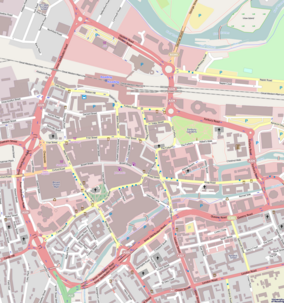Forbury Gardens
| Forbury Gardens | |
|---|---|

The Maiwand Lion, with Forbury Hill behind and to the left
|
|
| Type | Public |
| Location | Reading, Berkshire, UK |
| Coordinates | 51°27′25″N 0°58′2″W / 51.45694°N 0.96722°WCoordinates: 51°27′25″N 0°58′2″W / 51.45694°N 0.96722°W |
| Operated by | Borough of Reading |
Forbury Gardens is a public park in the town of Reading in the English county of Berkshire. The park is on the site of the outer court of Reading Abbey, which was in front of the Abbey Church. The site was formerly known as the Forbury, and one of the roads flanking the current gardens is still known as The Forbury. Fairs were held on the site three times a year until the 19th century.
Forbury, a suburb of the New Zealand city of Dunedin, was named after the gardens by early resident William Henry Valpy, who was born in Reading.
Reading Abbey was founded in 1121, by Henry I, and for the next four centuries it dominated the town, becoming one of the most influential establishments in England. Like other such monasteries, Reading had a forbury, or 'borough in front', an area of open land which provided a meeting place between the Abbey and the town. The Forbury in Reading was part of the outer court of the Abbey, and provided a market place as well as a meeting place.
In 1150, what is now Forbury Hill was constructed to help fortify the Abbey during the civil war between King Henry I's daughter, Matilda, and his nephew, Stephen.
The abbey was largely destroyed in 1538 during Henry VIII's Dissolution of the Monasteries. The last abbot, Hugh Cook Faringdon, was subsequently tried and convicted of high treason and hanged, drawn and quartered in front of the Abbey Church. After this, the buildings of the abbey were extensively robbed, with lead, glass and facing stones removed for reuse elsewhere, and the focus of the town moved away from the Forbury.
...
Wikipedia


